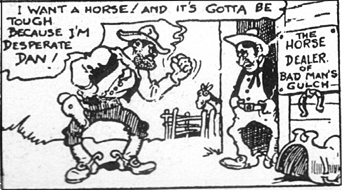Desperate
Dan
(1938-present)
 Dan's
Wild West origins were just the launching point for ever
more outlandish adventures. For this reason, it also
didn't matter that Dan's Cactusville home was clearly
Dundee, complete with street-lamps, post boxes and steam
rollers, as his adventures often took him off around the
world. Each page could be a mini epic - indeed, each
frame could be.
Dan's
Wild West origins were just the launching point for ever
more outlandish adventures. For this reason, it also
didn't matter that Dan's Cactusville home was clearly
Dundee, complete with street-lamps, post boxes and steam
rollers, as his adventures often took him off around the
world. Each page could be a mini epic - indeed, each
frame could be. -
- Sadly, as with other Watkins
strips, Desperate Dan fares badly in terms of 'political
correctness'. Racial sterotypes abound; Watkins seemed to
have a particular fondness for Chinese mandarins, but
Sikhs, Afro-Americans, Mexicans, Eskimos and various
other nationalities, with greater or lesser justification
for their presence, were constant fixtures.
Following Watkins' death in 1969,
the Beano employed other artists to take over Lord Snooty and
Biffo the Bear. Interestingly the Dandy, still under original
editor Albert Barnes, apparently did not consider doing the same
with Desperate Dan. From 1969 right through to 1982,
Watkins' work lived on in the form of re-prints of earlier
stories. The second Desperate Dan book was published in
1978, reprinting several long-running stories from the fifties.
When Barnes finally retired,
incoming editor Maurice Heggie swiftly appointed a new artist,
Watkins disciple Ken H Harrison. He has continued to draw the
strip ever since, except for a year or two in the mid-late
nineties when Bananaman creator John Geering had a try. This may
have been an attempt to give the strip a more modern,
action-packed style, but ifso it did not find favour, and
Harrison was eventually reinstated.
At around this time, the strange
decision was taken to render the dialogue in Desperate Dan in
phonetic speech. This didn't look right at all and was eventually
overturned by new editor ?? in 1998. Dan was also moved back
inside the comic (replaced on the cover by Cuddles and
Dimples).
 Dan's
Wild West origins were just the launching point for ever
more outlandish adventures. For this reason, it also
didn't matter that Dan's Cactusville home was clearly
Dundee, complete with street-lamps, post boxes and steam
rollers, as his adventures often took him off around the
world. Each page could be a mini epic - indeed, each
frame could be.
Dan's
Wild West origins were just the launching point for ever
more outlandish adventures. For this reason, it also
didn't matter that Dan's Cactusville home was clearly
Dundee, complete with street-lamps, post boxes and steam
rollers, as his adventures often took him off around the
world. Each page could be a mini epic - indeed, each
frame could be.